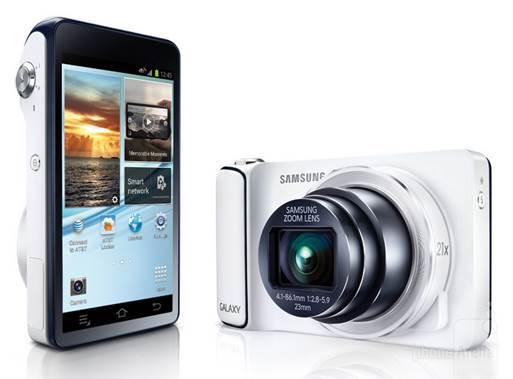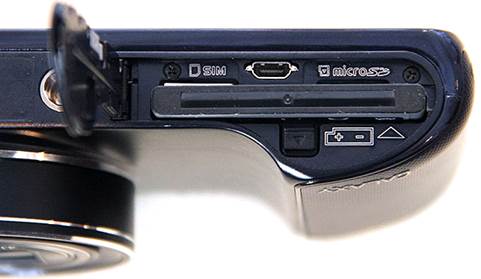There is no interrogation or objection for
Samsung representatives at IFA, but honestly, the silent atmosphere at the
introduction seminar of the Galaxy Camera was just for politeness. It was
inevitable that most journalists at the seminar were there mainly to see the
Galaxy Note II, which was surely a hot spot of the show. The recent release of
a half-hearted Android camera – Coolpix S800 running on Gingerbread from Nikon
also caused many worry. Finally, some people there, including us, might have
been blown off by the “convergence” talk of Samsung, implying the fact that
Galaxy Camera had micro-SIM slot for mobile HSPA+ data. Last but not least, the
whole notion of converged hardware lost its attractions that it used to have.
It might be hybrid, might be modular, but please, do not be a camera-phablet.

Samsung
Galaxy Camera
However, the problem is that Galaxy Camera
is not a converged device. It is just a camera, as simple as that. It seems merely
like a camera connected to a glossy world of Android. More special, we are
looking at Jelly Bean sitting astride the optically stabilized 21x zoom lens
and 16-MP sensor, roughly half of an inch which has been implemented in the Wi-Fi
WB850F camera of Samsung. These accessories can dominant anything that you can
find in the most photo-conscious smartphone. If you wish to label it, it would
make more sense to describe them as a software convergence. The operating
system and similar cloud-connected applications have thoroughly transformed
cellphones, tablets and TV are now being deployed in cameras – and there is no
reason that we should not dedicate to this new role. At least, do not neglect
the curiosity for this device until reading this review.
Hardware

Galaxy
Camera’s thickness
It has been clear that the Galaxy Camera’s
weight is greater than a normal compact camera, and it does not bring the same
feeling as a phone does. The maximum thickness is 35 mm (with the closed lens),
which means that it is just fitted in a breast pocket or a baggy shorts, but
the 305 g weight might make you purchase a case, a belt or a strap. At least,
you will want to have the bundled wrist strap, because even having the Gorilla
Glass screen, this camera cannot suffer a fall and its surfaces are indeed
smooth.
In reality, the lack of protruding dials
and buttons is one of the most notable differences between these cameras and
its non-Android cousin, WB850F. As you may see later, the large 4.8 inch
touchscreen display is used to process most of the camera controls. Like in the
physical aspect, there are only a power/standby button, a pop-up flash button,
a combined zoom knob and a shutter release.
Of course, it has many different ports and
inputs. They include a microphone on the top of the camera and speakers below
the flash button, allowing you to use the camera as a VoIP phone. On the right
hand side, we see a 3.5 audio jack and a micro-USB port which is very
convenient to charge the device with a tripod mount and battery compartment
flap, which can easily be opened if the device left freely in your bag. Open
that lid, you will see a SIM slot –if you have a data packet, it provides you
with a directly unique solution to share your photos when you are beyond the Wi-Fi
coverage.

The
SIM slot
That SIM slot is obviously interesting but
it is just one of many ways to load the photos in or out of the device.
Although other normal cameras write data on large-size SD memories, Galaxy
Camera can shoot to its 4 GB internal storage or to the micro-SD memory which
has already been installed on smartphones or tablets with particular data plan.
More comfortable, because Galaxy Camera also has Wi-Fi, you can connect it with
a smartphone or MiFi which is our favorite way to use the device. If you by
chance own a phone which has Wi-Fi Direct, you would be able to beam photos and
video directly from your camera with a surprisingly high speed. All connecting
options converge on a similar question: Why you have to pay more money for 1
SIM with the data plan working only for this camera?
It is sure that some authorities and
experienced users will invest their money in a dedicated SIM, if they need to
load photos over the Internet everyday to meet strict deadlines. Over time, it
might also possible to develop remote control applications for the camera as
the result of the direct cellular data connection enhancement and admittedly,
we cannot forecast all of the applications of this super connected camera. However,
for normal use, the SIM slot can be consider just like an unnecessary detail. Honestly,
one of the biggest joys of using this camera for us is to browse, edit and
share photos while being at home or hotel. In this case, the camera is
connected with the local Wi-Fi network. If the cheaper non-modem model of
Galaxy Camera would have been launched, that’s a missed opportunity to make the
device well-known.
Display

Galaxy
Camera’s screen
A feature that may cause few conflicts is
the HD Super Clear LCD which is very large, bright and lively. Only when you
start capturing photos through a window of this size – maybe on Galaxy S III or
Galaxy Note II – you will recognize how much the large-size screen helps
framing and organizing. Moreover, the 1,280x720 display successfully handles
its mission of fending off the direct sunlight, which means you will be
sometimes not aware of the absence of the electronic viewfinder – although
Galaxy Camera seems to be large enough to contained one. An abnormal omission
is the automatic brightness, which means sometimes will find out that you are
wasting so much battery for a stack of unnecessary lumens.
As you will see when we check the software
interfaces of the camera, the giant screen is essential to manage the creative
control feature of the camera, because most of the aspects of the exposure are
controlled by touching the screen. It is the least requirement to take the
whole advantage of Android – not only the play back and easy photo editing
ability but also a large enough keyboard on the screen for typing comments,
messages… In other words, this power consumed component is not only justified
by the photo taking but also what you tend to do after capturing the photos.
In short, the Galaxy Camera’s panel does
not belong to the best that we have ever seen for regular use. It totally
focuses on the brightness and outside viewing. When presenting the document,
the characters seem to be blurred at their edge because of the pixel density or
sub-pixel. Compared to the LCD screen of HTC One X, the abnormal position of
the dots really makes them seem awkward like a PenTile screen. Notwithstanding,
this component targets more on the photo viewing than documents editing and it
excellently fulfill its job.